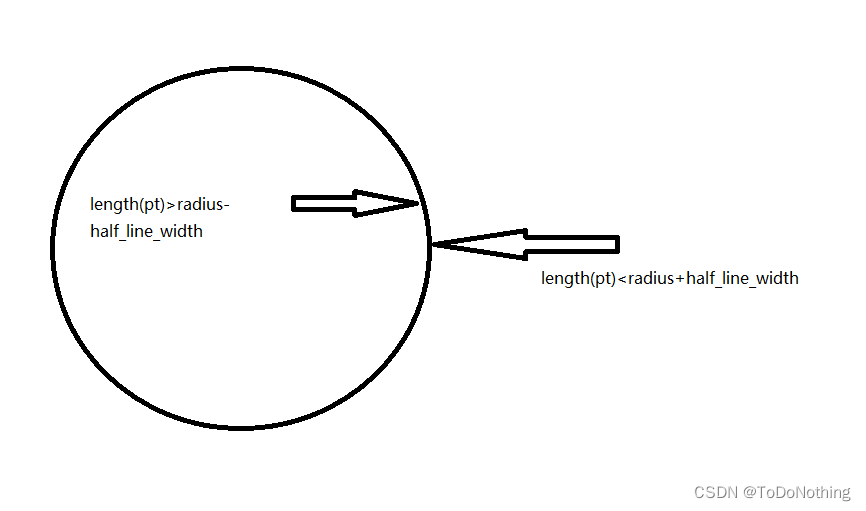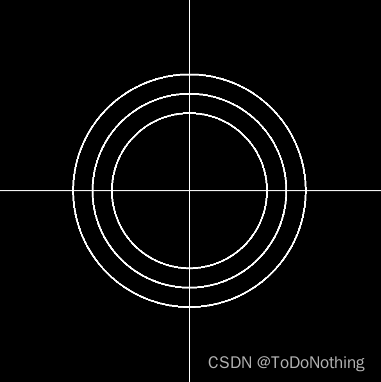本期主要通过shader实现雷达扫描效果,如下所示

根据效果,我们需要先画一个轮廓圆,代码如下
Shader "Unlit/shader7"
{
///鼠标移动正方形
Properties
{
_Center("Center",Vector)=(0,0,0,0)
_Raduis("Radius",float)=0.1
}
SubShader
{
Tags {
"RenderType"="Opaque" }
LOD 100
Pass
{
CGPROGRAM
#pragma vertex vert
#pragma fragment frag
#include "UnityCG.cginc"
struct v2f{
float4 vertex:SV_POSITION;
float4 position:TEXCOORD1;
float2 uv:TEXCOORD;
};
v2f vert(appdata_base v){
v2f o;
o.vertex=UnityObjectToClipPos(v.vertex);
o.position=v.vertex;
o.uv=v.texcoord;
return o;
}
//中心点
float4 _Center;
//半径
float _Raduis;
//绘制正方形
float rect(float2 pt,float2 size,float2 center){
float2 p=pt-center;
float2 halfsize=size*0.5;
float hotz=step(-halfsize.x,p.x)-step(halfsize.x,p.x);
float vert=step(-halfsize.y,p.y)-step(halfsize.y,p.y);
return hotz*vert;
}
//普通的实心圆
float circle(float2 pt,float2 center,float radius){
float2 p=pt-center;
return 1.0-step(radius,length(p));
}
//边缘软化圆
float circle(float2 pt,float2 center,float radius,bool soften){
float2 p=pt-center;
float edge=(soften)?radius*0.05:0.0;
return 1.0-smoothstep(radius-edge,radius+edge,length(p));
}
//轮廓圆
float circle(float2 pt,float2 center,float radius,float line_width){
float2 p=pt-center;
float len=length(p);
float half_line_width=line_width/2.0;
return step(radius-half_line_width,len)-step(radius+half_line_width,len);
}
fixed4 frag (v2f i) : SV_Target
{
float2 pos=i.position*2;
float2 size=0.2;
float outlineCircle=circle(pos,_Center,_Raduis,0.01f);
fixed3 col=fixed3(1,1,0)*outlineCircle;
return fixed4(col,1.0);
}
ENDCG
}
}
}
代码中的轮廓圆,是在实心圆的基础上进行绘制,实心圆需要绘制半径内所有点的颜色信息,而轮廓圆,只需要绘制轮廓线即可,因此只需要取半径radius+half_line_width和radius-half_line_width范围之内的点即可,如下图所示
,只要判断出在该点范围内进行输出即可。

代码中使用到了两个step函数,可以将结果控制在该范围内,如下图所示,只要是在该范围内,就输出1,不在该范围,都输出0。

在以上代码的基础上,我们还需要画线,线的代码如下所示
//画线
float onLine(float a,float b,float line_width,float edge_thickness){
float half_line_width=line_width*0.5;
return smoothstep(a-half_line_width-edge_thickness,a-half_line_width,b)-smoothstep(a+half_line_width,a+half_line_width+edge_thickness,b);
}
在该函数中,使用了smoothstep函数,该函数的意义如下
float smoothstep(float a, float b, float x)
{
x = clamp((x - a) / (b- a), 0.0, 1.0);
return x * x * (3 - 2 * x);
}
当a<b,x<a时 返回0 x>b时,返回1 否则在a和b之间平滑过渡
当a>b,x>a时,返回0,当x<b是,返回1。具体可参考了解shader函数
回到画线的函数中,a和b分别为线的x,y点位置,line_width为线的宽度,edge_thickness为线的厚度,通过smoothstep判断点是否在该范围内,这里根据的是x和y的坐标来判定的,稍微有一点难理解,最好就是自己画图输入参数证明一下。
完成画圈和直线的函数之后,在片元着色器里面处理一下
fixed4 frag (v2f i) : SV_Target
{
float2 pos=i.position*2;
float2 size=0.2;
float ouline1=onLine(i.uv.y,0.5,0.002,0.001)*_AxisColor;
float ouline2=onLine(i.uv.x,0.5,0.002,0.001)*_AxisColor;
float outlineCircle=circle(pos,_Center,_Raduis,0.01f);
fixed3 col=ouline1+ouline2+outlineCircle;
col+=circle(pos,_Center,_Raduis-0.1,0.01f);
col+=circle(pos,_Center,_Raduis-0.2,0.01f);
return fixed4(col,1.0);
}
可以得到以下图形:

接下来,画扫描线,需要用到一个非常关键的内置函数_Time,该函数可以实现循环输出数值的一个效果
t是自该场景加载开始所经过的时间,4个分量分别是 (t/20, t, t2, t3)
_Time float4 time (t/20, t, t2, t3)
//扫描线
float sweep(float2 pt,float2 center,float radius,float line_width,float edge_thickness){
float2 d=pt-center;
float theta=_Time.z;
float2 p=float2(cos(theta),-sin(theta))*radius;
float h=clamp(dot(d,p)/dot(p,p),0.0,1.0);
float l=length(d-p*h);
return 1.0-smoothstep(line_width,line_width+edge_thickness,l);
}
扫描线主要是根据向量d的位置,计算到循环出来的p点的距离,然后判断距离是否在范围内,在这个过程中使用了点乘dot函数计算点d投影到p的长度,该长度h使用了clamp函数进行限制,限制范围在0-1内。得到h后,计算点到p的距离,先使用d-p*h获得该投影点的向量,再使用length函数。得到的效果如下:

最后,再加上扫描的延迟阴影,整体代码如下:
//扫描线
float sweep(float2 pt,float2 center,float radius,float line_width,float edge_thickness){
float2 d=pt-center;
float theta=_Time.z;
float2 p=float2(cos(theta),-sin(theta))*radius;
float h=clamp(dot(d,p)/dot(p,p),0.0,1.0);
float l=length(d-p*h);
float gradient=0.0;
const float gradient_angle=UNITY_PI*0.5;
if(length(d)<radius){
float angle=fmod(theta+atan2(d.y,d.x),UNITY_TWO_PI);
gradient=clamp(gradient_angle-angle,0,gradient_angle)/gradient_angle*0.5;
return gradient+1.0-smoothstep(line_width,line_width+edge_thickness,l);
}
延迟阴影这部分主要是针对点d与p之间的角度进行处理,原理也是对角度进行判断和计算,涉及到较多数学问题,后面有机会再细讲,这里只讲用到的函数
fmod:返回a / b的浮点余数
atan2:返回反正切值
完整代码:
Shader "Unlit/shader7"
{
///鼠标移动正方形
Properties
{
_Center("Center",Vector)=(0,0,0,0)
_Raduis("Radius",float)=0.1
_AxisColor("AxisColor",Color)=(1,1,0,1)
}
SubShader
{
Tags {
"RenderType"="Opaque" }
LOD 100
Pass
{
CGPROGRAM
#pragma vertex vert
#pragma fragment frag
#include "UnityCG.cginc"
struct v2f{
float4 vertex:SV_POSITION;
float4 position:TEXCOORD1;
float2 uv:TEXCOORD;
float4 screenPos:TEXCOORD2;
};
v2f vert(appdata_base v){
v2f o;
o.vertex=UnityObjectToClipPos(v.vertex);
o.position=v.vertex;
o.uv=v.texcoord;
o.screenPos=ComputeScreenPos(o.vertex);
return o;
}
//中心点
float4 _Center;
//半径
float _Raduis;
fixed4 _AxisColor;
//绘制正方形
float rect(float2 pt,float2 size,float2 center){
float2 p=pt-center;
float2 halfsize=size*0.5;
float hotz=step(-halfsize.x,p.x)-step(halfsize.x,p.x);
float vert=step(-halfsize.y,p.y)-step(halfsize.y,p.y);
return hotz*vert;
}
//普通的实心圆
float circle(float2 pt,float2 center,float radius){
float2 p=pt-center;
return 1.0-step(radius,length(p));
}
//边缘软化圆
float circle(float2 pt,float2 center,float radius,bool soften){
float2 p=pt-center;
float edge=(soften)?radius*0.05:0.0;
return 1.0-smoothstep(radius-edge,radius+edge,length(p));
}
//轮廓圆
float circle(float2 pt,float2 center,float radius,float line_width){
float2 p=pt-center;
float len=length(p);
float half_line_width=line_width/2.0;
return step(radius-half_line_width,len)-step(radius+half_line_width,len);
}
//画线
float onLine(float a,float b,float line_width,float edge_thickness){
float half_line_width=line_width*0.5;
return smoothstep(a-half_line_width-edge_thickness,a-half_line_width,b)-smoothstep(a+half_line_width,a+half_line_width+edge_thickness,b);
}
//扫描线
float sweep(float2 pt,float2 center,float radius,float line_width,float edge_thickness){
float2 d=pt-center;
float theta=_Time.z;
float2 p=float2(cos(theta),-sin(theta))*radius;
float h=clamp(dot(d,p)/dot(p,p),0.0,1.0);
float l=length(d-p*h);
float gradient=0.0;
const float gradient_angle=UNITY_PI*0.5;
if(length(d)<radius){
float angle=fmod(theta+atan2(d.y,d.x),UNITY_TWO_PI);
gradient=clamp(gradient_angle-angle,0,gradient_angle)/gradient_angle*0.5;
}
return gradient+1.0-smoothstep(line_width,line_width+edge_thickness,l);
}
fixed4 frag (v2f i) : SV_Target
{
float2 pos=i.position*2;
float2 size=0.2;
float ouline1=onLine(i.uv.y,0.5,0.002,0.001)*_AxisColor;
float ouline2=onLine(i.uv.x,0.5,0.002,0.001)*_AxisColor;
float outlineCircle=circle(pos,_Center,_Raduis,0.01f);
fixed3 col=ouline1+ouline2+outlineCircle;
col+=circle(pos,_Center,_Raduis-0.1,0.01f);
col+=circle(pos,_Center,_Raduis-0.2,0.01f);
col+=sweep(pos,_Center,_Raduis,0.002,0.001)*_AxisColor;
return fixed4(col,1.0);
}
ENDCG
}
}
}